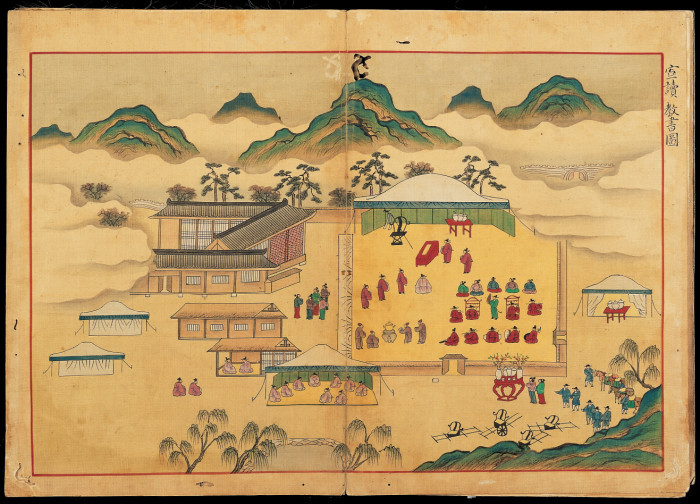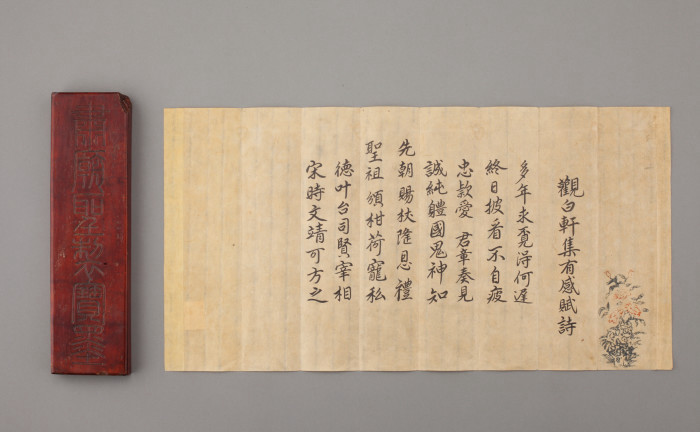경기문화재단
Treasure No. 930, Received Treasure-Class Cultural Properties Donated
GyeonGi Provincial Museum,
Treasure No. 930, Received Treasure-Class Cultural Properties Donated
GyeonGi Provincial Museum (Director Seong-Hwan Kim) received a total of 218 artifacts and 611 artifacts from Yong-woo Lee, the leading descendant of Jeonju Lee Family, Deokcheon-gun-pa, Baekheon-sanggong. Donated relics include Treasure No. 930 Lee Gyeong-seok gwejang and Sagwejang Banquet Book, Treasure No. 1630 Sukjong Eopil Chileon Poem, as well as old books and ancient documents, folk relics and calligraphy relics that have been kept at the Jongga family for generations. Jeon Joo-i is a major family in Gyeonggi Province that produced three major scholars over four generations, centering on Baek Heon, Lee Gyeong-seok (1595~1671), a college student in the middle of the Joseon Dynasty. Lee Gyeong-seok was the last son of the royal family, a person who worked as a prime minister during the period when the country was in crisis due to Jeong Myo-ho-ran. He passed Jinsha City in 1613 (Gwanghae-gun’s 5th year), and in 1626 (Injo’s 4th year), he was a manor from liberal arts. In 1636 (Injo’s 14th year), during Byeongjahoran, he built the ‘Samjeon Inscription’ as a subjehak, and later served as a master of Daeje and Yijopanseo. And went to Shenyang. After returning to Korea, he went through Ichopanseo, Woouijeong, and Jwauijeong, and served as Yeonguijeong in 1649 (accomplished by Hyojong), and in 1659 (Hyojong’s 10th year), he entered Giroso as a vice president of Young Donnyeong. Located in Seok-dong, Seongnam-si, Gyeonggi-do, Lee Gyeong-seok's grave is Gyeonggi-do Monument No. 84.

▲<Treasure> Treasure No. 930 / Joseon 1668 / Lacquered on wood / Chest 55 x 72.5cm, length 190
The donated gukjang was given directly to the king in 1668 (Hyunjong’s 9th year), when Lee Gyeong-seok was 74 years old, and is a total of 6 relics including 1 chair and 4 staffs. During the Joseon Dynasty, as a government official of the Dangsanggwan or higher, he allowed him to withdraw from the office at the age of 70, but even after he was over 70 years old, he was unable to do so because of his affairs. Among these people, the king gave special chairs and staffs to Jeong 1pum officials. Lee Gyeong-seok entered Giroso in 1664, and in 1668 (Hyeonjong’s 9th year), when he was 74 years old, he was given the highest honor as a servant. In the ``Sagwejangjigamnok'' of Lee Gyeong-seok's collection of books, Baekheonjip, the reasons for receiving the ark, a textbook given by the king, and the courts including Jeong Tae-hwa of Yeonguijeong in honor of this honor at the time There is a record of inviting all the honorable godfathers of the university to Gwejangyeon and expressing their congratulations through poems. The gukjang, which was produced in Gongjeon, operated by the country, is a representative craft of the Joseon Dynasty that shows the production regulations and styles at that time. The chair follows the marriage ritual, an ancient ark, and can be unfolded if necessary, and the seating area is made of X-shaped strings. Bumgeum, the part where the cane touches the ground, is decorated with square-shaped iron. In particular, in the case of the small-headed cane, the head is carved into a bird shape, and a small spray is attached to the end. As such, in the Joseon Dynasty, there was a custom of giving arks to many elders over the age of 70, so there are some records of this, but the only thing that remains in life is Lee Gyeong-seok’s ark, which is historically and materially valued very high.

▲ <Saguijang Banquet Map Picture Book> Part of the book of Sundogyo / Treasure No. 930 / Joseon 1668, painted on silk, 42.5 x 60
In the case of a banquet, the picture book was designated as Treasure No. 930 along with the gukjang. The king personally gave a feast when giving the ark chief, and the picture of the gwejangyeon is divided into three pictures vividly. The first width is <Jiyeonggwejangdo>, which depicts the image of a central priest who enters Lee Gyeong-seok's priest and meets the procession carrying the textbook and arkjang, and the second width is <Sondokyoseodo> depicts a scene in which the king's textbook is read and delivered, and the third section is <internal and external temperature>, which shows a banquet after the ceremony is over and Do Seungji raises a note. Along with the picture, the book contains a textbook and a chair, a poem of the attendees, a congratulatory poem made by relatives who could not attend the banquet, and a poem expressing the joy of Lee Gyeong-suk himself.

▲<Sukjong Appeal Chileon Poetry> Treasure No. 1630 / 28.2 x 58.3
This is a chileon poem given by Sukjong, the 19th king of the Joseon Dynasty, to Lee Gyeong-suk's descendants as a poem that read Lee Gyeong-seok's book, Baekheonjip, and wrote about the feeling. As the most credible example of Sukjong's vocabulary of Mukjeok that has been known to this day, this esoteric writing using a colored floral pattern is also in the ‘Sukjong Yesterday’. It is listed and has a high value as an appeal material. It is stored in a wooden pencil case separately made by descendants. He tried to ask for many years, but he couldn't, but he did not know that he was tired even after reading all day.

▲<Hongpae (Lee Kyung-Seokmun Supercharge System)> Joseon 1626/92 x 68.3
It is a teaching paper that proves that Jojwa Lee and Gyeongseok Lee were paid as a manor in the Gap Division, which emphasized the munition. Priority is one of the past systems of the Joseon Dynasty, and it is a regular test that was shown once every ten years to members of the Dang-Ha-gwan and below. The emphasis has been given several times, but the passing textbook is rarely passed on, and the example is very rarely found as a chapter-level textbook. In addition to the relics already designated as treasures, the donated relics include paintings of Gyehoedo Island in which Lee Gyeong-seok participated, as well as ancient books and documents of Lee Gyeong-seok and his descendants from the 17th to 19th centuries. School magazines, green plaques and municipalities, as well as Chinese and Korean books owned by the family are gathered together, and are evaluated as having excellent value as cultural assets such as academic research materials and exhibition materials.
Donor Lee Yong-woo (Jeonju-i, Deokcheon-gun, Baekheon Sang-in-chief), said, “The reason I donated the relics of my predecessor that my grandfather, father, and mother had kept with all their sincerity was because I hope that they can be preserved for a long time in a good environment. I hope the museum manages and researches these materials well.”
GyeonGi Provincial Museum Director Kim Seong-hwan said, “This donation of Baek Heon-gong’s servant, Yong-woo Lee, is a very meaningful work not only for us, but also for Korea, as he donated a collection of artifacts from generations to generations from an important family in Gyeonggi-do. I am grateful for the big and noble heart of the donor for doing so.”
The GyeonGi Provincial Museum plans to deliver a plaque of appreciation to the donor to honor the spirit and will of the donor who willingly donate the precious relics stored for generations to come. Some of the donated artifacts will be exhibited in time for the reopening, and if preservation is necessary, he has announced that he will make efforts to publicize its value by opening it to the residents as soon as it is completed.
<ggc의 모든 콘텐츠는 저작권법의 보호를 받습니다.>